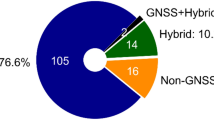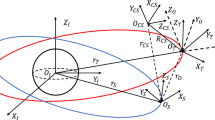Abstract
A new satellite orbit prediction method based on artificial neural network (ANN) model is proposed to improve the precision of orbit prediction. In order to avoid the difficulty of amending the dynamical model, it is attempted to use ANN model to learn the variation of orbit prediction error, and then the prediction result of ANN model is used to compensate the predicted orbit based on dynamic model to form a final predicted orbit. The experiment results showed that the orbit prediction error based on ANN model was less than that based on dynamical model, and the improvement effects for different satellites and different time were different. The maximum rates of improvement of predicting 8, 15, 30 d were respectively 80 %, 77.77 %, 85 %. The orbit prediction error control technique based on the method of back overlap arc compare was brought forward to avoid the risk that the precision of predicted orbit is even worse after it is compensated by ANN model. The phenomena of failure were basically eliminated based on this technique, and the rate of failure was reduced from 30 % to 5 %. This technique could ensure that the engineering application of ANN model could come true.




Similar content being viewed by others
References
Zhou S, Cao Y, Zhou J et al (2012) Positioning accuracy assessment for the 4GEO/5IGSO/2MEO constellation of COMPASS. Sci China Phys Mech Astron 55:2290–2299
Zhou S, Hu X, Wu B et al (2011) Orbit determination and time synchronization for a GEO/IGSO satellite navigation constellation with regional tracking network. Sci China Phys Mech Astron 54:1089–1097
Helleputte T, Doornbos E, Visser P et al (2009) CHAMP and GRACE accelerometer calibration by GPS-based orbit determination. Adv Space Res 43:1890–1896
Visser P, Ijssel J, Helleputte T et al (2009) Orbit determination for the GOCE satellite. Adv Space Res 43:760–768
Sibthorpe A, Bertiger W, Desai S et al (2011) An evaluation of solar radiation pressure strategies for the GPS constellation. J Geodesy 85:505–517
Rodriguez-Solano C, Hugentobler U, Steigenberger P et al (2011) In: Precise GNSS orbit determination using an adjustable box-wing model for solar radiation pressure, IUGG, Melbourne, Australia, 7 January 2011
Gobinddass ML, Willis P, Viron O et al (2009) Improving DORIS geocenter time series using a empirical rescaling of solar radiation pressure models. Adv Space Res 44:1279–1287
Chen J, Wang J (2006) Solar radiation pressure models for the GPS satellites. Acta Astronom Sin 47:310–319 (in Chinese)
Springer TA, Beutler G, Rothacher M (1999) A New Solar Radiation Pressure Model for GPS Satellites. Adv Space Res 23:673–676
Lampinen J, Vehtari A (2001) Bayesian approach for neural networks—review and case studies. Neural Netw 14:257–274
Hagan M, Menhaj M (1994) Training feedforward networks with the Marquardt algorithm. IEEE T Neural Networ 5:989–993
Holmstrom L, Koistinen P (1992) Using additive noise in back-propagation training. IEEE T Neural Networ 3:24–38
Liu T (2007) Estimation of GPS satellite orbit and ephemeris with quasi neural network and polynomial curve fit. Dissertation, Taiwan University of Science and Technology, Taibei, pp 20–100 (in Chinese)
Zhou J (2011) A new method of middle-term and long-term orbit prediction for navigation satellite. Acta Geo Cart Sin 40:39–45 (in Chinese)
IGS final orbit (2011) IGS netting. http://igscb.jpl.nasa.gov/components/prods_cb.htm. Accessed 1 June 2011
Satish K (2006) Neural networks, second edn. Qinghua University Publishing House, Beijing, pp 35–80
Acknowledgments
We would like to thank Prof. Bo Xu from Nanjing University for providing a orbit prediction method for GPS satellite. This work was supported by the National Natural Science Foundation of China (41204022) and the Opening Project of Shanghai Key Laboratory of Space Navigation and Position Techniques (12DZ2273300).
Conflict of Interest
The authors declare that they have no conflict of interest.
Author information
Authors and Affiliations
Corresponding author
About this article
Cite this article
Li, X., Zhou, J. & Guo, R. High-precision orbit prediction and error control techniques for COMPASS navigation satellite. Chin. Sci. Bull. 59, 2841–2849 (2014). https://doi.org/10.1007/s11434-014-0346-y
Received:
Accepted:
Published:
Issue Date:
DOI: https://doi.org/10.1007/s11434-014-0346-y




